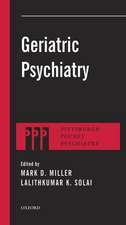Drug Therapy for the Elderly
Editat de Martin Wehlingen Limba Engleză Paperback – 18 aug 2012
Whereas recent approaches have recommended to remove particular drugs from the medication regimen to avoid adverse effects, Drug Therapy for the Elderly underlines both indispensable and dispensable elements of drug treatment in order to provide an overall assessment of drugs suitable for the aged. In view of the multimorbidity and polypharmacy situations experienced by elderly patients, this book takes into account the special needs and requirements shown by this group, thus serving as a timely reference for physicians who treat the elderly.
Preț: 798.55 lei
Preț vechi: 840.58 lei
-5% Nou
Puncte Express: 1198
Preț estimativ în valută:
152.80€ • 159.54$ • 126.46£
152.80€ • 159.54$ • 126.46£
Carte tipărită la comandă
Livrare economică 05-19 aprilie
Preluare comenzi: 021 569.72.76
Specificații
ISBN-13: 9783709109113
ISBN-10: 3709109116
Pagini: 300
Ilustrații: XV, 356 p. 53 illus., 35 illus. in color.
Dimensiuni: 178 x 254 x 20 mm
Greutate: 0.91 kg
Ediția:2013
Editura: SPRINGER VIENNA
Colecția Springer
Locul publicării:Vienna, Austria
ISBN-10: 3709109116
Pagini: 300
Ilustrații: XV, 356 p. 53 illus., 35 illus. in color.
Dimensiuni: 178 x 254 x 20 mm
Greutate: 0.91 kg
Ediția:2013
Editura: SPRINGER VIENNA
Colecția Springer
Locul publicării:Vienna, Austria
Public țintă
Professional/practitionerCuprins
Foreword.-
Part 1: General aspects.-
Part 2: Special considerations with regard to organ systems based on geriatric clinical importance.-
Part 3: Pharmacotherapy and geriatric syndromes.-
Part 4: Further problem areas in gerontopharmacotherapy and pragmatic recommendations.
Part 1: General aspects.-
Part 2: Special considerations with regard to organ systems based on geriatric clinical importance.-
Part 3: Pharmacotherapy and geriatric syndromes.-
Part 4: Further problem areas in gerontopharmacotherapy and pragmatic recommendations.
Recenzii
From the reviews:
“This book explores the issues specific to prescribing medications to the elderly. … This book does require some basic understanding of physiology, but it is fascinating reading for clinicians with that basic understanding. … It does a very impressive job of covering what happens in aging. … This is a most interesting book. It has tremendous value in academic settings with medical students, social workers, nurses, etc., as it is one of the more complete books on the subject of therapies for the elderly.” (Vincent F. Carr, Doody’s Review Service, January, 2013)
“This book explores the issues specific to prescribing medications to the elderly. … This book does require some basic understanding of physiology, but it is fascinating reading for clinicians with that basic understanding. … It does a very impressive job of covering what happens in aging. … This is a most interesting book. It has tremendous value in academic settings with medical students, social workers, nurses, etc., as it is one of the more complete books on the subject of therapies for the elderly.” (Vincent F. Carr, Doody’s Review Service, January, 2013)
Textul de pe ultima copertă
With people aged 65 years and older currently making up the fastest growing age group throughout the world, the demographic revolution of an aging society will inevitably lead to increased pressure to develop a rationalistic and age-tailored process of diagnosis and treatment among the elderly. As aging people often suffer from several chronic diseases and are being treated with multiple medications concurrently, unwanted drug interactions occur more frequently.
Whereas recent approaches have recommended to remove particular drugs from the medication regimen to avoid adverse effects, Drug Therapy for the Elderly underlines both indispensable and dispensable elements of drug treatment, providing the practitioner with:
- Background information on the elderly population regarding their needs for particular drugs (with an eye to frailty, co-morbidity patterns, and special sensitivities regarding drug metabolism and excretion)
- Practical advice about drug treatment surveillance parameters in the elderly
- In-depth discussion of drugs in relation to the elderly with specific diagnoses
- Integration of multimorbidity/polypharmacy situations into prioritization schemes
- A plan for how to deal with the complexity of polypharmacy situations in a five-minute consultation
An original classification of drugs is proposed by the editor which relates the power of effects, prognostic data, and tolerability to a prioritization scoring system. This approach is the first to not only provide a negative listing, but also integrates positive data into an overall assessment for drugs fit for the aged. Therefore, Drug Therapy for the Elderly serves as a timely reference for a wide array of physicians.
Whereas recent approaches have recommended to remove particular drugs from the medication regimen to avoid adverse effects, Drug Therapy for the Elderly underlines both indispensable and dispensable elements of drug treatment, providing the practitioner with:
- Background information on the elderly population regarding their needs for particular drugs (with an eye to frailty, co-morbidity patterns, and special sensitivities regarding drug metabolism and excretion)
- Practical advice about drug treatment surveillance parameters in the elderly
- In-depth discussion of drugs in relation to the elderly with specific diagnoses
- Integration of multimorbidity/polypharmacy situations into prioritization schemes
- A plan for how to deal with the complexity of polypharmacy situations in a five-minute consultation
An original classification of drugs is proposed by the editor which relates the power of effects, prognostic data, and tolerability to a prioritization scoring system. This approach is the first to not only provide a negative listing, but also integrates positive data into an overall assessment for drugs fit for the aged. Therefore, Drug Therapy for the Elderly serves as a timely reference for a wide array of physicians.
Caracteristici
Unique classification system to reduce the number of drugs taken by elderly patients Illustrated with helpful diagrams and tables Includes supplementary material: sn.pub/extras









